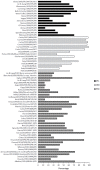Nonadherence to Medication Therapy in Haemodialysis Patients: A Systematic Review
- PMID: 26636968
- PMCID: PMC4670103
- DOI: 10.1371/journal.pone.0144119
Nonadherence to Medication Therapy in Haemodialysis Patients: A Systematic Review
Abstract
Background: End-stage kidney disease (ESKD) patients are often prescribed multiple medications. Together with a demanding weekly schedule of dialysis sessions, increased number of medicines and associated regimen complexity pre-dispose them at high risk of medication nonadherence. This review summarizes existing literature on nonadherence and identifies factors associated with nonadherence to medication therapy in patients undergoing haemodialysis.
Methods: A comprehensive search of PubMed, Embase, CINAHL, PsycInfo, and Cochrane Database of Systematic Reviews covering the period from 1970 through November 2014 was performed following a predefined inclusion and exclusion criteria. Reference lists from relevant materials were reviewed. Data on study characteristics, measures of nonadherence, prevalence rates and factors associated with nonadherence were collected. The Preferred Reporting Items for Systematic Reviews and Meta-analyses (PRISMA) guidelines was followed in conducting this systematic review.
Results: Of 920 relevant publications, 44 were included. The prevalence of medication nonadherence varied from 12.5% to 98.6%, with widespread heterogeneity in measures and definitions employed. Most common patient-related factors significantly associated with nonadherence were younger age, non-Caucasian ethnicity, illness interfering family life, being a smoker, and living single and being divorced or widowed. Similarly, disease-related factors include longevity of haemodialysis, recurrent hospitalization, depressive symptoms and having concomitant illness like diabetes and hypertension. Medication-related factors such as daily tablet count, total pill burden, number of phosphate binders prescribed and complexity of medication regimen were also associated with poor adherence.
Conclusions: A number of patient-, disease-, and medication-related factors are associated with medication nonadherence in haemodialysis patients. Clinicians should be aware of such factors so that adherence to medications can be optimised in haemodialysis patients. Future research should be directed towards well-designed prospective longitudinal studies developing standard definitions and validating available measurement tools, while focusing on the role of additional factors such as psychosocial and behavioural factors in predicting nonadherence to medications.
Conflict of interest statement
Figures


References
-
- Lysaght MJ (2002) Maintenance dialysis population dynamics: current trends and long-term implications. J Am Soc Nephrol 13 Suppl 1: S37–40. - PubMed
-
- De Jager DJ, Grootendorst DC, Jager KJ, van Dijk PC, Tomas LM, Ansell D, et al. (2009) Cardiovascular and noncardiovascular mortality among patients starting dialysis. J Am Med Assoc 302: 1782–1789. - PubMed
-
- Manley HJ, Cannella CA, Bailie GR, Peter WL (2005) Medication-related problems in ambulatory hemodialysis patients: a pooled analysis. Am J Kidney Dis 46: 669–680. - PubMed
Publication types
MeSH terms
LinkOut - more resources
Full Text Sources
Other Literature Sources
Medical

